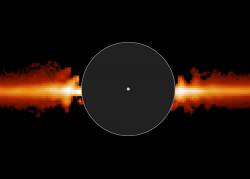 The Hubble Space Telescope has imaged a ring of dust around a nearby star that will probably become a system of planets. The star is AU Microscopii, and it’s located about 32 light-years away in the southern constellation of Microscopium (the Microscope). The particles are probably as fluffy as snowflakes, and about 10 times larger than typical interstellar dust grains.
The Hubble Space Telescope has imaged a ring of dust around a nearby star that will probably become a system of planets. The star is AU Microscopii, and it’s located about 32 light-years away in the southern constellation of Microscopium (the Microscope). The particles are probably as fluffy as snowflakes, and about 10 times larger than typical interstellar dust grains.
This discovery was announced by US and Canadian astronomers at the annual meeting of the American Astronomical Society, held in Seattle, Washington. They used Hubble’s Advanced Camera for Survey’s coronagraph and polarizing filters to look at the light reflecting off the debris disk.
By viewing the light through the polarizing filters, they were able to study how the dust is reflecting sunlight. This gave them information about the dust’s size, shape, and other physical properties.
Material this size must have been shed by much larger, unseen snowball-sized objects that have been gently colliding with each other. As these larger objects bump into each other, they release a flurry of particles which are then caught up in the star’s stellar wind and pushed outward.
